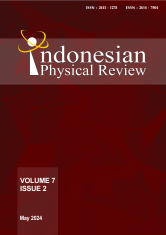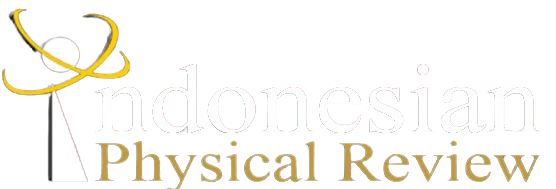SPECTRUM AND TIME-FREQUENCY ANALYSIS TO CHARACTERIZE MICROTREMOR DATA IN SEPAKU SUB-DISTRICT, EAST KALIMANTAN
DOI:
10.29303/ipr.v7i2.282Downloads
Abstract
Microtremor analysis has been done in the Sepaku Sub-District as a part of the New Capital City of Indonesia. This study aims to determine the characteristics of microtremors in the Sepaku Sub-District using Spectrum Analysis and Time-Frequency Analysis (TFA). Data in this study were taken using a seismometer on the 18 measurement points. The data were processed using default analysis from Geopsy software. Spectrum analysis and TFA used Fourier Transform to change time domain data into the frequency domain. Both analysis ways result in the characteristic microtremor data in the research area. The spectrum analysis data obtained shows two frequency ranges with maximum peaks: middle-frequency (5-8.8 Hz) and high-frequency (11.5-17.6 Hz). Afterward, the TFA shows similar results, where the characteristics of microtremor data are divided into two zones. The maximum peak occurs at the middle-frequency range of 5-10 Hz, and the high frequency ranges above 10 Hz
Keywords:
Spectrum analysis Time-frequency analysis MicrotremorReferences
H. K. Rahmat, H. Syarifah, A. Kurniadi1, R. M. Putra. (2021) Sri Wanda Wahyuni. Implementasi Kepemimpinan Strategis Guna Menghadapi Ancaman Bencana Banjir Dan Tsunami Di Provinsi Kalimantan Timur. Jurnal Manajemen Bencana. 7 (1), 1-18.
R. Brackenridge, U. Nicholson, B. Sapiie, D. Stow & D. R. Tappin. (2020). Indonesian Throughflow as a preconditioning mechanism for submarine landslides in the Makassar Strait. Geological Society, London, Special Publications.
A. Herlambang. (2022). Estimasi Potensi Air Tanah Penajam Untuk Mendukung Kebutuhan Air Bersih IKN di Penajam Kalimantan Timur. Jurnal Sains dan Teknologi Mitigasi Bencana, Vol.16, No. 2
L. Hartati. (2014). Pemetaan Tingkat Resiko Gempabumi Daerah Liwa dan Sekitarnya Berdasarkan Pengukuran Mikrotremor, (Tesis) Program Studi Magister Fisika, Universitas Gajah Mada, Yogyakarta.
S.S. Arifin, B.S.Mulyanto, Marjiyono, dan R. Setianegara. (2014). Penentuan Zona Rawan Guncangan Bencana Gempa Bumi Berdasarkan Analisis Nilai Amplifikasi HVSR Mikrotremor dan Analisis Periode Dominan Daerah Liwa dan Sekitarnya. Jurnal Geofisika Eksplorasi, 2 (1), 30-40.
N. Haerudin, F. Alami, & Rustadi. (2019). Mikroseismik, Mikrotremor Microearthquake dalam ilmu kebumian. Pusaka Media. Bandar Lampung.
S.T. Gustono, M. Akhadi, K.S. Azzahra. (2020). The Change of Rock Condition Observed by H/V Spectral and Ellipticity Curve Inversion Analysis (Case Study: Palu Earthquake September 28, 2018). SPEKTRA: Jurnal Fisika dan Aplikasinya, 5(3), 201-212.
U.Habibah, N.B.Wibowo, D.Darmawan. (2017). Karakteristik Mikrotremor Berdasarkan Analisis Spektrum, Analisis TFA (time frequency analysis) dan analisis seismisitas pada kawasan jalur sesat Opak. Jurnal Fisika 6 (2). 93-101.
R. Hafid H., Supriyadi, N. Kholifatun N, Tahlisiamita A, F. Rohmaniyah .(2017). Percepatan Tanah Berdasarkan Data Mikroseismik Wisata Bantir Sumowono. Unnes Physics Journal. 6 (1). 54-59.
M.H. Syahrudin, S. Aswad., E.F. Palullungan, Maria & Syamsudin (2014). Penentuan Profil Ketebalan Sedimen Lintasan Kota Makasar dengan Mikrotremor. Jurnal Fisika 4 (1)
C. Nurjaya. (2011). Identifikasi Fluida Berdasarkan Analisis Atenuasi Energi Wavelet Berbasis Short Time Fourier Transform, Continous Wavelet transform dan stockwell transform (tesis). Universitas Indonesia.
S.Y. Mantiri. (2016). Studi Mikrotremor Dengan Metode Hvsr di Distrik Heram, Kota Jayapura. SAINS, 16 (2), 54 – 60.
L. Cohen. 1995. Time-Frequency Analysis. New York: Prentice-Hall.
M. Arisalwadi, S. Maryanto, dan H.Triastuty. (2017). Analisis Spektral dan Waveform Cross Correlation Tremor Vulkanik Gunungapi Bromo Jawa Timur Pada Letusan Tahun. NATURAL B, 4(1). 57-64.
SESAME, 2004, Guidelines for the Implementation of the H/V Spectral Ratio Technique on Ambient Vibration Measurements and Interpretation, SESAME Europan Research Project, European Commision-Research General Directorate.
S. Koesuma, M. A. H. Putera, dan Darsono. (2019). A microtremor analysis for microzonation of seismic vulnerability index by using horizontal to vertical spectral ratio in the southern area of Klaten regency. Journal of Physics: Conference Series. 1153 (012023). 1-6.
M. Masyelina, N.B. Wibowo, dan D. Darmawan. (2014). Karakteristik mikrotremor dan analisis seismisitas pada jalur sesar Opak, kabupaten Bantul, Yogyakarta. J. Sains Dasar 2014 3(1) 95 – 101.
S.S. Arifin , B.S. Mulyatno , Marjiyono, & R. Setianegara (2014). Penentuan Zona Rawan Guncangan Bencana Gempa Bumi Berdasarkan Analisis Nilai Amplifikasi Hvsr Mikrotremor Dan Analisis Periode Dominan Daerah Liwa Dan Sekitarnya. Geofisika Eksplorasi, 2(1), 30-46.
A. Herlambang. (2022). Estimation of Groundwater Potential of Penajam Region to Support The Need for Clean Water in IKN Penajam East Kalimantan. Jurnal Sains dan Teknologi Mitigasi Bencana, 16(2).
License

This work is licensed under a Creative Commons Attribution-NonCommercial-ShareAlike 4.0 International License.
Authors who publish with Indonesian Physical Review Journal, agree to the following terms:
- Authors retain copyright and grant the journal right of first publication with the work simultaneously licensed under a Creative Commons Attribution-ShareAlike 4.0 International Licence (CC BY SA-4.0). This license allows authors to use all articles, data sets, graphics, and appendices in data mining applications, search engines, web sites, blogs, and other platforms by providing an appropriate reference. The journal allows the author(s) to hold the copyright without restrictions and will retain publishing rights without restrictions.
- Authors are able to enter into separate, additional contractual arrangements for the non-exclusive distribution of the journal's published version of the work (e.g., post it to an institutional repository or publish it in a book), with an acknowledgment of its initial publication in Indonesian Physical Review Journal.
- Authors are permitted and encouraged to post their work online (e.g., in institutional repositories or on their website) prior to and during the submission process, as it can lead to productive exchanges, as well as earlier and greater citation of published work (See The Effect of Open Access).





